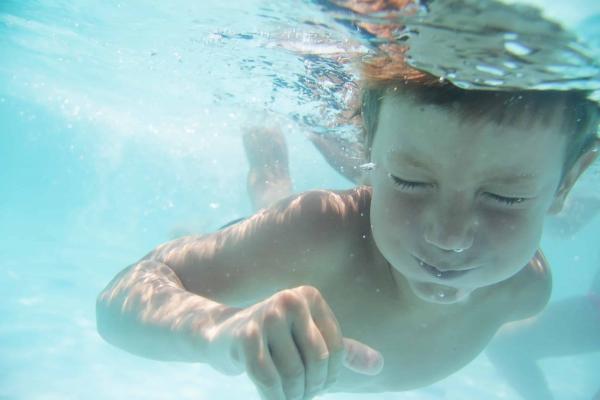
Swim season is here, and I'm sure many parents have water safety on their minds. Whether you plan on bringing your family to a water park, a lake, the beach or even just the backyard pool, it's crucial to be aware of the possible ways your child could drown.
According to the CDC, drownings are a leading cause of injury deaths for young children (ages one to 14). In fact, drowning kills more children ages one to four than anything else, except birth defects.
As scary as these statistics are, there is one important and more practical thing all parents need to know about drowning: it doesn't always look like we expect it to. Movies show children thrashing and screaming, noisily trying to keep their head above water. In reality, your child is more likely to drown in these four ways:
1. Quietly in the pool (or lake or ocean)
Mario Vittone, a former Coast Guard rescue swimmer, says that people do not instinctively make a ruckus when drowning. Instead, their body's number one response is to try inhaling and exhaling rather than screaming. And instead of splashing around and flailing their arms above water, their hands instinctively stay under water and try to push the water down to get their heads up.
In other words, when a child drowns in a pool or other body of water, they usually don't make a scene. Instead, the incident is quiet and easy to miss.
The CDC suggests helpful ways to protect your kids from fatal drowning:
-
Learn life-saving skills, including CPR
-
Fence off backyard swimming pools
-
Make your kids wear life jackets always while in or around natural bodies of water
-
Be on the lookout whenever your kids are around water
2. In the kiddie pool
Yep, those cheap plastic kiddie pools you fill up with the garden hose present a serious danger to your little ones. Even though they're normally pretty shallow, face-down drownings are a genuine possibility.
According to Nina Shapiro, doctor of pediatric otolaryngology, "over 10% of pool-related deaths in young children occur in what are best known as 'kiddie pools,'" and many of these child shallow pool drownings take place during a lack or lapse of adult supervision.
As parents, we can do a couple things to avoid these unexpected drownings. First off, be vigilant about adult supervision while your children play in kiddie pools -watching them from the kitchen sink window won't cut it. Make your kids get out for a second if you have to run inside for a ringing phone or doorbell. Also, always remember to completely empty out the kiddie pools when they're not in use.
3. In any water around the house
You wouldn't expect a bucket, fish tank or toilet bowl to present a drowning danger, but children can drown in less than two inches of water. From a shallow bath tub to an empty pot filled with rain water, it's important to be aware that if a child can place their face in it, they can drown. Any amount of water that can cover a kid's mouth and nose is dangerous.
It only takes 10 seconds for a child to submerge their face in a pool of water, two minutes to lose consciousness and four to six minutes to sustain permanent brain damage.
Be aware of all sources of water in and around your home and teach your children from a young age to avoid putting their heads under water.
4. After they've left the pool
We most likely think the risk of drowning is over once we're away from the water. But there's a possibility of drowning long after you've driven your kiddos away from the pool - it's called dry-drowning.
Essentially, dry drowning occurs when a child chokes and ingests water while swimming. But instead of reaching the lungs, the water is breathed into the child's vocal cords, causing them to spasm and close up after your kid has already hopped out of the water. Within one to 24 hours, dry drowning shuts off a child's airways, making it very hard to breathe.
Of course, children choke on water all the time without experiencing dry drowning. According to WebMD, the symptoms that set dry-drowning apart are:
-
Coughing
-
Chest pain
-
Trouble breathing
-
Feeling extremely tired
-
Irritability
All these unexpected drowning possibilities sound scary, but you don't have to restrict your kids from ever touching water again. Just practice good water safety (including appropriate floaties and life jackets) always have constant adult supervision and teach your kids how to swim to reduce the risk.


